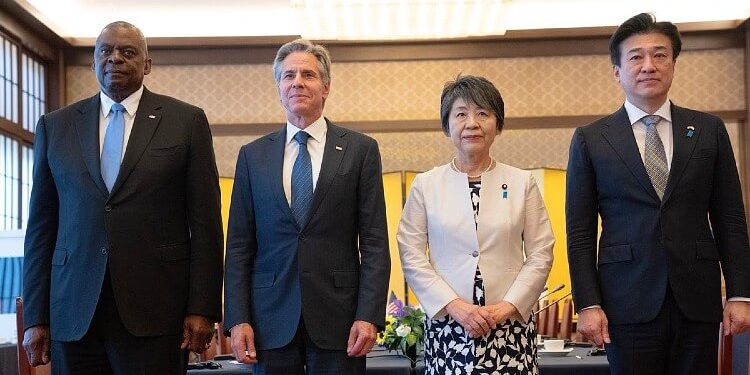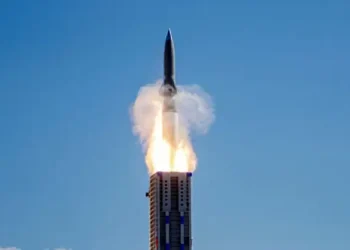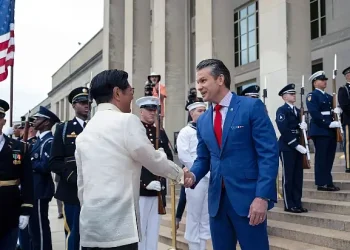At a pivotal meeting in Tokyo, U.S. Secretary of State Antony J. Blinken and Secretary of Defense Lloyd J. Austin III joined Japanese Foreign Minister Kamikawa Yoko and Defense Minister Kihara Minoru to discuss the future of the U.S.-Japan alliance.
The talks centered on bolstering defense capabilities, addressing regional security threats, and deepening bilateral cooperation.

A New Era in U.S.-Japan Relations
The U.S.-Japan 2+2 ministerial meeting marked a significant moment for both nations, emphasizing the modernization of their alliance. This meeting underscored a shared commitment to adapting to the evolving security landscape in the Indo-Pacific region.
Outcomes of the Meeting:
- Modernization of Alliance Command and Control:
- The U.S. Forces Japan will be upgraded to a Joint Force Headquarters, with expanded missions and responsibilities. This marks the most substantial change to the command structure since its inception, enhancing the alliance’s operational capabilities.
- Japan is also establishing a new Joint Operations Command to streamline coordination with U.S. forces, aiming for more cohesive and effective defense strategies.
Enhancing Regional Presence and Cooperation
The ministers discussed increasing the bilateral presence in the Southwest Islands, a strategic region crucial for regional security. They highlighted the importance of local engagement and coordination to sustain military activities and reinforce the defense posture.
Bilateral Cooperation Areas:
- Cybersecurity and Intelligence:
- The meeting reaffirmed the critical need for cooperation in cybersecurity and intelligence, surveillance, and reconnaissance (ISR). These areas are vital for maintaining a technological edge and ensuring robust defense mechanisms.
- Joint exercises and training will continue to be a focal point, enhancing interoperability and readiness.
- Defense Industrial Cooperation:
- New initiatives for defense industrial cooperation were explored, including missile co-production and ship repair. Strengthening supply chain resilience is also a priority, ensuring that both nations can maintain operational readiness in the face of potential disruptions.
Addressing Regional Security Concerns
The meeting also focused on broader regional security issues, particularly concerning China’s military actions and the strategic partnership between China and Russia. The ministers expressed shared concerns over these developments, which challenge the international order.
U.S.-Japan Defense Collaboration Areas
Area |
Focus |
|---|---|
| Modernization | Joint Force Headquarters, Joint Operations Command |
| Regional Presence | Southwest Islands, local engagement |
| Cybersecurity and Intelligence | ISR, joint exercises |
| Defense Industrial Cooperation | Missile co-production, supply chain resilience |
Extended Deterrence and Commitment
For the first time, a separate ministerial meeting focused exclusively on extended deterrence, demonstrating the U.S. commitment to defend Japan with a full spectrum of conventional and nuclear deterrence capabilities. This underscores the importance both nations place on maintaining a robust and credible deterrence posture in the region.
- Strengthening Alliances with Like-minded Countries:
- The U.S. and Japan are also collaborating with other nations, including Australia and the Republic of Korea (ROK), to enhance security cooperation. These partnerships are crucial for achieving a free and open Indo-Pacific.
- Focus on Okinawa:
- The ministers reiterated their commitment to mitigating the impact of U.S. military presence on local communities in Okinawa. They emphasized the importance of relocating the Marine Corps from Futenma to Henoko to ensure the long-term viability of the alliance’s strategic presence.
Bottom Line
The U.S.-Japan 2+2 meeting has set a clear path for deepening the partnership between the two nations.
By modernizing their alliance, enhancing regional cooperation, and addressing security challenges, the U.S. and Japan are solidifying their roles as key players in maintaining stability and peace in the Indo-Pacific region.
As they move forward, this strengthened alliance will be crucial in navigating the complexities of the current geopolitical landscape.
More information about these Ministerial Meetings with Japan.
Sources: THX News & US Department of State.









